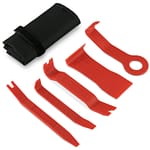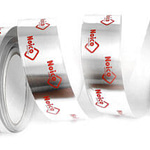The untreated metal surfaces on your car will resonate, causing the noise you hear. By stopping this, you can drastically reduce this sound traveling through your vehicle.
This also improves your sound system and stops the rattling noise. The foil covering provides some thermal insulation.
If you’re looking at using any sound deadening material in your car, then you’ve probably considered Dynamat as an option. I’ll briefly lay out the steps to install Dynamat and all other sound-deadening self-adhesive materials in this post.
Applying Dynamat is fairly simple. It literally is as easy as peel-and-stick.
The challenge comes in getting to the surfaces on which you plan on applying the Dynamat. Almost always, you’re required to disassemble, remove and then prepare the surface area before application.
Table of Contents
How to install Dynamat
- Firstly, measure the area you want to cover
- Next purchase the right Dynamat product for your project
- Then prepare the surface area you plan on using for the Dynamat installation
- After that, peel off the self-adhesive protective layer on the Dynamat
- Lay the Dynamat in place
- Finally, use a roller to ensure adhesion
You should check your car’s manual first. For around $20, you can find a detailed version. The easiest way to find the hard copy repair manual for your vehicle is to select Repair Manuals by Make and Model. Or you can get an electronic version. They both have all sorts of instructions and guides, whether it’s for customization, maintenance, repair, or even simply just learning about the inner workings of a particular vehicle.
What you’ll need

A panel removal tool kit is required for the panel pins. This is because they avoid breakage of the pins during the removal of them. It’s also useful for prying away the panels without doing damage to your vehicle’s paint job.

Aluminum tape is also needed. You can patch up the parts where there might be gaps left or use the tape to give your application a clean finish.

Wear a good pair of workman’s gloves while working with the material. The foil edges are sharp and cut through your skin. The glue is also best avoided.

You can use metal shears instead of scissors for products like Dynamat and others. You can also use a switchblade.

Use the correct seam sealer (if required) to avoid it setting and causing ripples on your trunk lid. In addition, the seam sealer should maintain some flex when dries.
You may want to get a set of additional Bumper Retainer Clips, just in case you damage some or if you find a few missing already.

Use a portable light system to make it easier for you to see.
Step 1 – Preparing the surface

In this step, all you must do is clean the area you want to install Dynamat to.
First, use a vacuum or hand brush to clear away any small objects. If there is any old foam stuck to the metal skin, remove that also.
Then, using rubbing alcohol, clean off any grease, glue, or oil marks. This is done to ensure good adhesion of the Dynamat to the surface.
Once you’re satisfied that the surface area you plan on covering is adequately cleaned, you’re ready for the next stage.
Step 2 – Applying Dynamat

You can use a sharp blade to cut Dynamat. Once you’ve done all your cutting and ready to place the Dynamat, place the sheets down.
Most Dynamat products are self-adhesive. A protective layer covers the adhesive. Removing this layer reveals the adhesive side of the Dynamat.
The best thing to do when applying Dynamat is to firstly peel off approximately 2″ of the protective layer and lay the Dynamat in the desired place. The adhesive is strong and, once firmly in place, is not easily removed, so do this to make sure before you stick it all down. Then once you’re satisfied with the placement, carefully remove the balance of the protective layer from underneath while firmly pressing down on the Dynamat. At this stage, using your hand is sufficient.
Care must not impede the mounting spaces with the sound deadening material to ensure easy re-assembly.
Step 3 – Using the roller

Once the protective layer is completely removed, you will need to use the roller to roll out any creases or bubbles. This may take some time to do but will ensure the best result for the product.
Press down with the roller moving in a back and forward motion.
You should wear a pair of workman’s gloves, especially when you’re working on cavities like the door. The metal edges of your vehicle can be sharp and cut you while you’re busy. Also, you want to avoid getting the adhesive on your hands. Rolling the Dynamat in place will require effort.
You can use Dynatape to finish off the edges. Although this is not essential as the material edges are seldom exposed, it doesn’t usually peel off.
- Applying sound deadening to a car door.
- Applying sound deadening to the floor.
- Applying sound deadening to a car trunk.
National Consumer Center offers you a chance to get a $500 gift card to Amazon. The payouts are quick, and you can use the Gift Card to pay for some of your Amazon products.
Why choose Dynamat?
Again the disassembly process takes effort; you don’t want to be left wondering. So an extra dollar or two per sq. ft in perspective is well worth the cost of peace of mind. This is what makes Dynamat a solid investment.
There are no easy do-overs when it comes to butyl adhesive. Once it sets in place, it is complicated to remove it—another reason to do the job properly the first time around.
Purchasing the right Dynamat product for the job
Depending on the size of the area and the requirements of your project, choose the right product from Dynamat. They have a great number of different products for different areas of your car.
This part is important to avoid wastage and manage your budget. You also don’t want to run out mid-project after disassembly, so taking special care in having the right amount of product before you begin is a crucial step.
Dynamat does have custom cut packs for specific parts of vehicles. It offers these in its Xtreme product lines. Namely a door and trunk kit. They even offer speaker and license plate packs.
In a nutshell, SuperLite is, as the name suggests, a light version of the now-standard Xtreme version. Lighter makes it cheaper and slightly less effective.
These custom cuts are the same make-up as the packs. This variety can be useful for budgeting but is often overlooked by first-time buyers.

- HEX(4 sq.ft.) (Xtreme).
- BULK(36 sq.ft.) (Xtreme).
- MEGA(72 sq.ft.) (Xtreme).
- TRI(12 sq.ft.) (Superlite)
- BULK(48 sq.ft.) (Superlite)
By far, the most popular pack is the Xtreme Bulk Pak. It’s slightly cheaper per sq. ft And at 36 sq. ft Covers most soundproofing projects. To read more on Dynamat products’ specifics and help you choose the right pack size for your specific project, see my review post on DynaMat.
Dynatape is used to finish off any uneven areas to give the installation a professional look. Dynaroller is used to press down on the material to bind it to the surface area properly. I’ve detailed the various Dynamat products in another post where I’ve compared them to another market-leading supplier of automotive sound deadening material, Soundskins vs. Dynamat. I’ve detailed the various Dynamat products in another post where I’ve compared them to another market-leading supplier of automotive sound deadening material, Soundskins vs. Dynamat.
Where to use Sound Deadening Material
Sound Deadening material can be used on any metal surfaces. It can also be used on fiberglass panels, plastic, and vinyl. Almost any flat smooth surface you need.
On cars, they’re most commonly found on the floor. This is easily the most effective place to use sound deadening. The second most commonplace of use is the door panels. The metal inner skin and the plastic/vinyl coverings. The trunk is also covered. Very effective for improving the performance of your sound system. A must for subwoofers. You could even use it on the roof lining, a little over-kill, but it does provide thermal insulation.
Brands like Dynamat don’t stop there, though. They have a specialist range. Thermal insulation mainly. Under carpet insulation and padding. You can read more about it below.
How to install DynaLiner

Thermal insulators are usually heavy, so for a lightweight version, you should consider DynaLiner. The thermal insulation is achieved through the closed cell rubber, which is packed airtight.
It has peel-and-stick installation functionality. See the process of applying it above.
Because you have options of thickness, you can ensure clearance and still maximize effectiveness. You can use the chart above as a guideline.
How to install DynaPad

DynaPad is one of the few products that don’t have the peel-and-stick function. This lack of adhesive does have a plus side. The 3/8″ thick DynaPad can be easily moved.
DynaPad is installed under the carpet on the floor of your car. Or the interior firewall section. It can also be placed in the rear of the car and the trunk as it has an excellent effect against low-frequency exhaust and road noise while blocking heat.
You should install DynaPad ontop of Xtreme or SuperLite.
Hoodliner installation

An engine compartment treatment, Hoodliner has a pressure-sensitive adhesive. The peel-and-stick method is used to install.
An installation tip is to remove about 2” of the adhesive protective cover. Place it on the engine section to see it covers the engine adequately. Then lightly close the hood. The 3/4” Hoodliner will lightly stick to the underside of your hood. Check the Hoodliners placement. Once you’re happy with its cover, remove the balance of the adhesives protection sheet and press it into place.
Another method is to remove the hood completely. Lay it flat on an open area, and then apply the Hoodliner. Read my in-depth review of Hoodliner and its effectiveness here.
DynaPlate

DynaPlate is a self-adhesive damping material. It’s a solid aluminum sheet. It’s versatile and can be used anywhere to reinforce body panels.
The self-adhesive installation of DynaPlate makes it a popular choice on the market. Adding a second layer gives you the same sound deadening effect as Xtreme.
Conclusion
With its variety of products on offer, Dynamat is relatively inexpensive and easy to install. Other than the roller, the installation often does not require any special tools either. The products are also readily available online.
I hope you found this post helpful, feel free to comment on your experiences with Dynamat installation.
Good luck and happy soundproofing!
